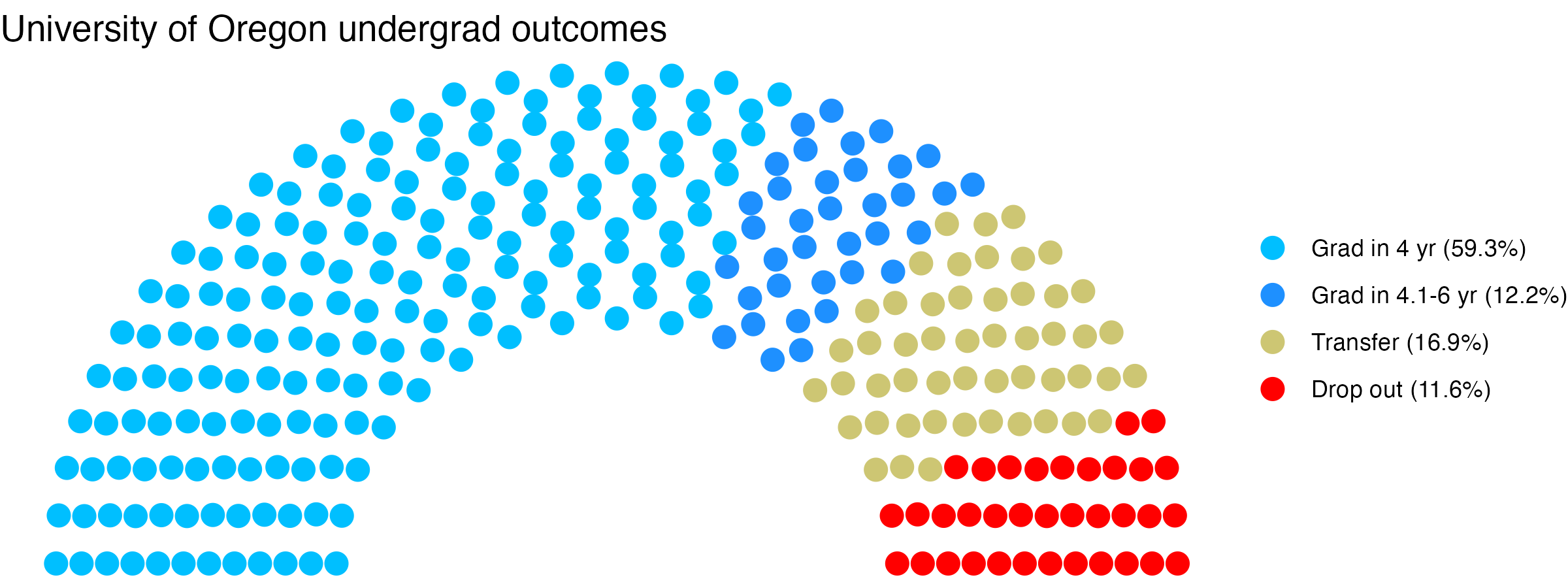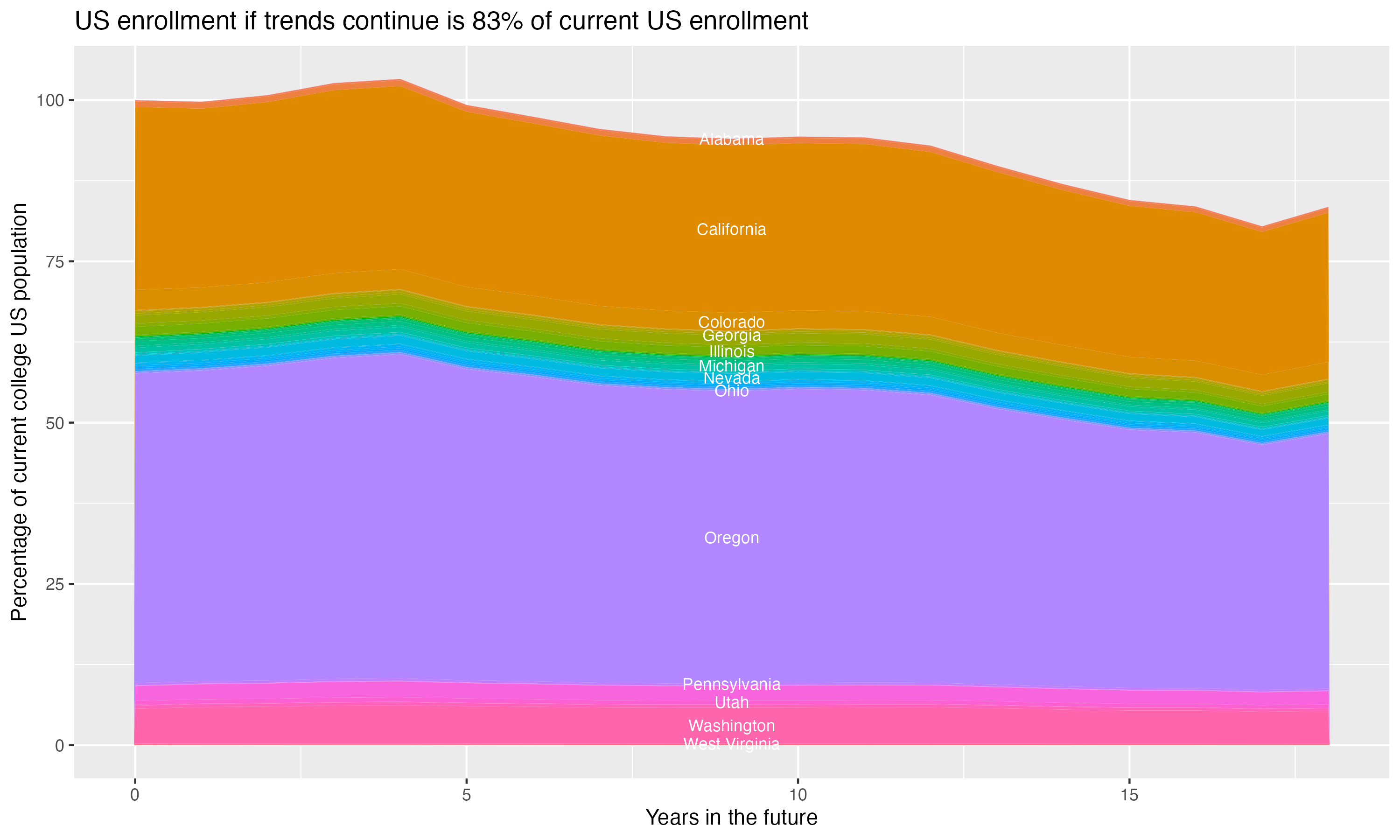University of Oregon
University of Oregon is located in Eugene, Oregon. It is a public, 4-year or above institution.
From Wikipedia: The University of Oregon (UO, U of O or Oregon) is a public research university in Eugene, Oregon, United States. Founded in 1876, the university is organized into nine colleges and schools and offers 420 undergraduate and graduate degree programs. The university also operates the Ballmer Institute for Children’s Behavioral Health in Portland, Oregon; the Oregon Institute of Marine Biology in Charleston, Oregon; and Pine Mountain Observatory in Central Oregon. UO’s 295-acre campus is situated along the Willamette River. Most academic programs follow the 10-week quarter system. The university is classified among “R1: Doctoral Universities – Very high research activity” and is a member of the Association of American Universities. Since July 2014, UO has been governed by its own board of trustees. UO student-athletes compete as the Oregon Ducks and are part of the Big Ten Conference in the NCAA Division I. With eighteen varsity teams, the Oregon Ducks are best known for their football team and track and field program. These two teams are even incorporated into the design of the school’s “O” logo. In the summer of 2022, UO hosted the 2022 World Athletics Championships. It was the first time the event was held in the United States. The university has a long and complex relationship with Nike, Inc., and the firm’s co-founder Phil Knight. As a consequence of state higher-education disinvestment starting in the 1990s, UO has embraced a “University of Nike” image. Fueled by large investments in athletic infrastructure, this trend has accelerated in recent years. Knight, an alumnus, has advocated for both athletic prominence and increased privatisation of the university, and has donated over $1 billion to UO since the late-1980s, much of it going towards athletics. The school’s “O” logo was designed by Nike in 1998 and sports facility projects on campus typically involve both Knight and Nike. The university’s motto, mens agitat molem comes from the Aeneid by Virgil,(Book VI, line 727).
Overview of institution
This, and the rest of the page, use info from the most recent year available, generally 2024.
Institution kind: Doctoral Universities: Highest Research Activity
Undergrad program: Arts & sciences plus professions, high graduate coexistence
Graduate program: Research Doctoral: Comprehensive programs, no medical/veterinary school
Enrollment profile: High undergraduate (see more details below)
Average net price for undergrads on financial aid: $23,917 (1.3 times the equivalent cost of Harvard).
Actual price for your family: Go here to see what your family may be asked to pay. It can be MUCH lower than the average price but also higher for some.
Size and setting: Four-year, large, primarily residential
In state percentage: 47% of first year students come from Oregon
In US percentage: 99% of first year students come from the US
Graduation rate (within 6 years) for students seeking a Bachelors: 71.5% (this is what is usually reported as “graduation rate”)
Graduation rate (within 4 years) for students seeking a Bachelors: 59.3%
Percent of students seeking a Bachelors who transfer out of this institution: 16.9%
Student to tenure-stream faculty ratio: 25.4 (undergrads to tenure-stream faculty) [Tenure explained]
Student to faculty ratio: 18.1 (undergrads to all faculty)
Degrees offered: Bachelor’s degree, Postbaccalaureate certificate, Master’s degree, Post master’s certificate, Doctor’s degree: research scholarship, Doctor’s degree: professional practice
Schedule: Quarter
Institution provides on campus housing: Yes
Dorm capacity: There are enough dorm beds for 5983 students
Freshmen required to live on campus: No
Advanced placement (AP) credits used: Yes
Disabilities: 17.30 percent of undergrads are registered as having disabilities.
Undergrad outcomes
This plot shows the outcomes for first time, full time undergraduates seeking Bachelor’s degrees (if the data are available).

Map
Comparisons
The sections below show this institution compared with others. The ones listed are ones it has identified as peers, who consider themselves peers, and/or who the federal government considers peers. If a comparison school has the same value as the focal school, its cell is grayed out. In fields where there is a common view that higher (or lower) values are better, the best values are in blue, the worst values are in red. If there isn’t a sense of a particular value being better, values are shown in varying shades of green. Arrows show where there is a signficant trend over time for a school. You can swipe across the table to see more of it; the focal school column is always visible.
- University of Oregon lists these schools as ones to compare itself within federal IPEDS data, and they do the same back: University of Michigan-Ann Arbor, University of Virginia-Main Campus, Indiana University-Bloomington, University of Colorado Boulder
- University of Oregon compares itself to these institutions, but not vice versa: University of North Carolina at Chapel Hill, University of Washington-Seattle Campus, University of California-Santa Barbara, University of Iowa
- These institutions compare themselves to University of Oregon, but not vice versa: Florida State University, University of Wisconsin-Madison, Purdue University-Main Campus, Pennsylvania State University-Main Campus, Rutgers University-New Brunswick, University of Pittsburgh-Pittsburgh Campus, Binghamton University, University of Massachusetts-Amherst, Stony Brook University, University of Delaware, Texas Tech University, University of Missouri-Columbia, Michigan State University, University of Oklahoma-Norman Campus, Iowa State University, Idaho State University, University of Kansas, University of Nevada-Reno, University of Arizona, Miami University-Oxford, Gonzaga University, University at Albany, Kent State University at Kent, University of Nevada-Las Vegas, University of Mississippi, Montana State University, Northern Arizona University, University of Wyoming, Old Dominion University, CUNY Graduate School and University Center, Western Oregon University
Enrollment

General
Teaching
Tenure track faculty are those who are eligible for tenure. This includes both pre-tenure and tenured faculty. Once faculty get tenure, they are (generally) protected from being fired for intellectual reasons, helping to ensure their freedom in teaching and research. They can still lose their positions for misconduct, financial problems, not fulfilling their duties, or other reasons.
Non-tenure track faculty are not eligible for tenure. Some are hired one semester at a time, some have multi-year contracts. They typically have a higher teaching load than tenure track faculty, leaving less time for research or other creative endeavors. They are also easier to fire than tenured faculty. Sometimes they are external experts (a noted musician, a former senator) who are hired to teach some classes without the expected permanence of a tenure-track position.
Note that this chart uses US federal demographic data: it only has two genders and a specified set of ethnicities and races.
Having a low student to faculty ratio is considered a good thing by many, as it can mean more individual attention.
Geography
This has information on the location of the institution. See the about page for more information on what the metrics are and how they are calculated.
Financial Aid
Graduation
Note these are bachelors graduation rates in six years, not four (this is standard). Sample sizes can be small for some demographic groups with few individuals in a school, leading to large year-to-year fluctuations and often extreme values for those groups (if there are two individuals in the class with a given identity, the possible graduation rates are 0%, 50%, or 100% depending on whether zero, one, or both students graduate within six years).
Library
Libraries are changing rapidly. Note that how institutions count digital collections may vary.
Diversity
The US Census Bureau has a diversity index that goes from 0 to 1. In their words, “A 0-value indicates that everyone in the population has the same racial and ethnic characteristics. A value close to 1 indicates that everyone in the population has different racial and ethnic characteristics.” This uses their formula, but with the resolution available for the federal IPEDS data (which does not separate for a given demographic group whether members identify as Hispanic or not). This metric is about heterogeneity within the population, not the proportion of the population that comes from historically excluded groups.
Following the practice of the census, the index is multiplied by 100 to give the percentage probability a random pair of individuals will have a different background. Most institutions argue that diversity is a benefit, so by default a higher number is listed as better, but there may be cases where this measure does not reflect the mission of a college (for example, 70% of the students at a tribal college or university may be American Indian: that could be low-scoring by this metric but should not be read as “bad” given the institution’s mission).
These numbers are based on the most recent year available, generally 2024, which predates effects of the US Supreme Court’s striking down of affirmative action. This has often changed, sometimes dramatically, the incoming student demographics at some institutions.
Overall diversity
Freshman profile
Demographic data for first time degree-seeking students. Note that this uses US federal demographic data: it only has two genders and a specified set of ethnicities and races.
Freshman geography
Test scores
SAT scores
ACT scores
Majors
This presents information on the number of majors and the median earnings one and five years after graduation for people who got a degree from this institution in that field. The earnings are for those who are working and not enrolled in further education. The earnings data (from the federal college scorecard) also has information on earnings for those categorized as ‘MALE’ and ‘NOMALE’ – for readability, these are recategorized here as “Men” and “Women”, respectively, which adopts the gender binary used in other federal data. “W/M earnings ratio” is the median earnings of women divided by men, as a percentage.
Bachelors
Masters
Doctorate
Certificate
Associates
Demographic cliff
There is a concern that giving changing US demographics, the number of students in the age groups who most commonly attend four year colleges will drop off, decreasing overall enrollment. This is often referred to as the “demographic cliff”, and it can be a concern for colleges concerned about the risk of falling enrollment. For this section, the analysis uses US census data on the number of people in each state by age, and the proportion of students that come from each state for this particular college, to crudely model what will happen if everything remains constant except the demographic change in the population of 18 year olds in each year – it does not account for things like the college increasing its admission rate, attracting more students from states without the same demographic changes or from other countries, or changes in the proportion of students who go to college.
